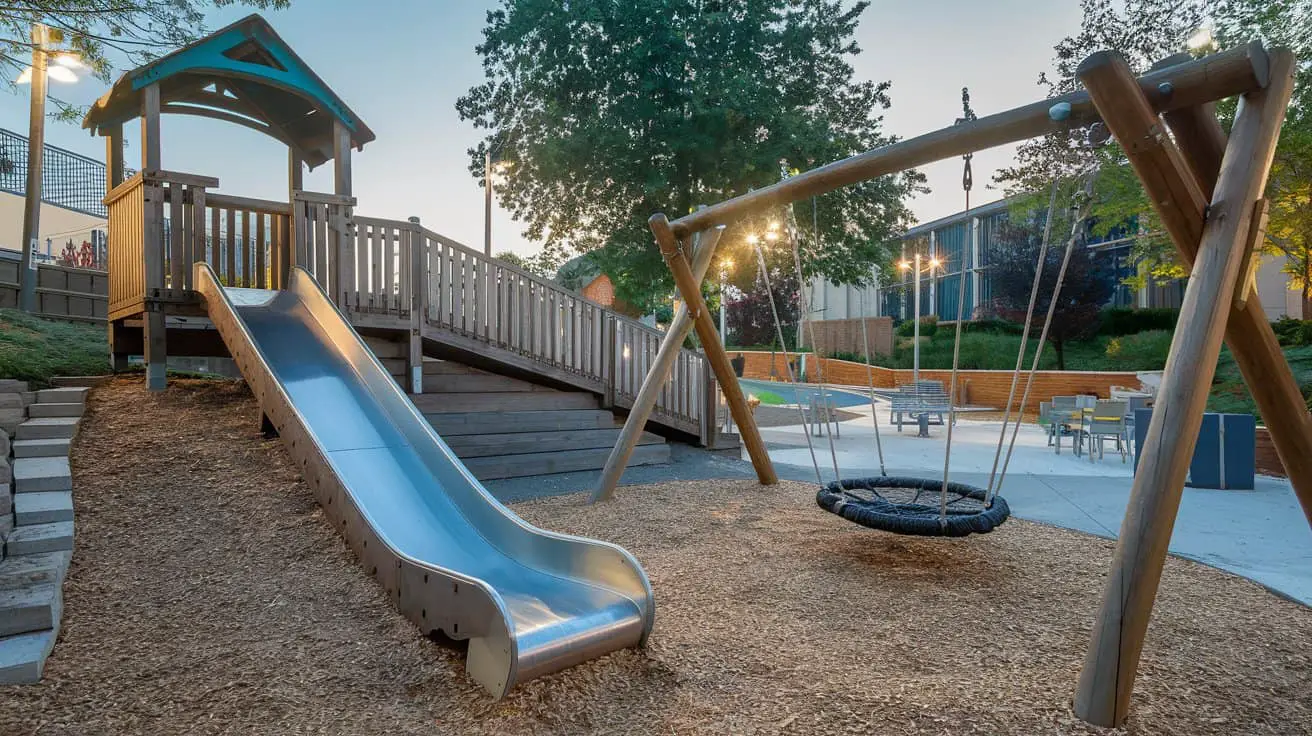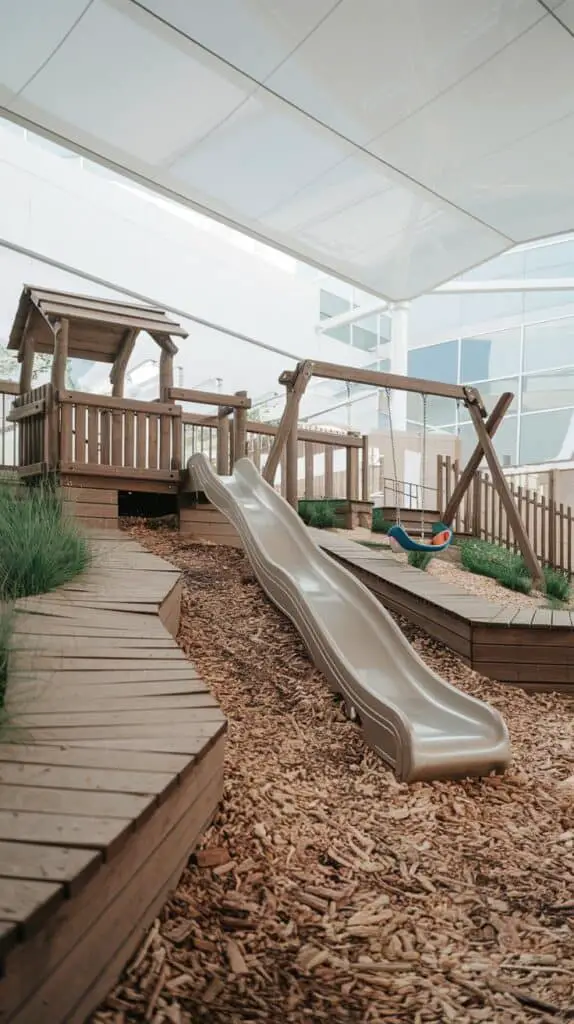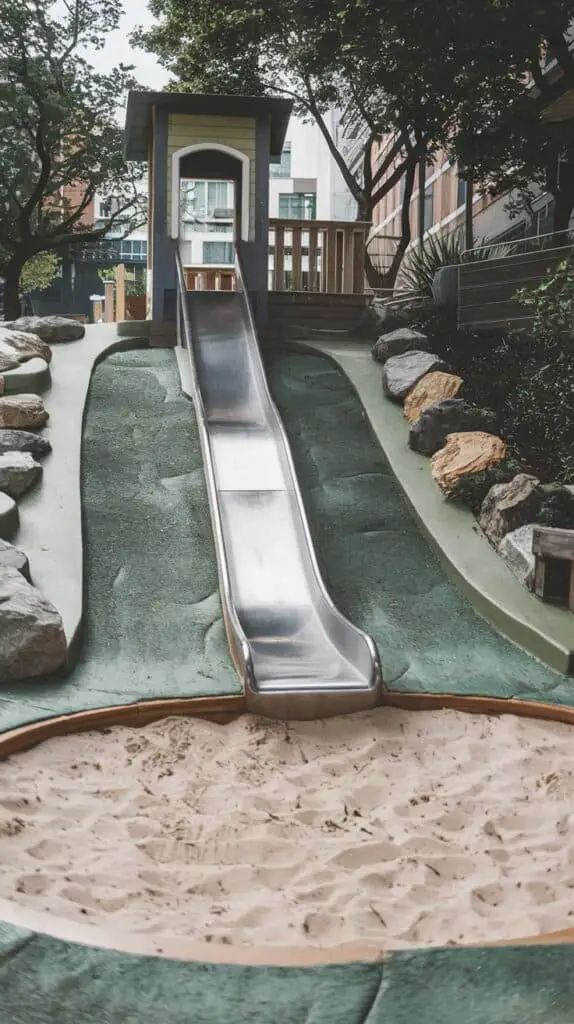
If your backyard has a slope, you’ve probably had that sinking feeling: “What on earth do we do with this?” I get it. Sloped yards can feel like more of a design problem than a playground opportunity—but I promise, with a bit of planning (and some smart choices), they can become one of the most exciting, dynamic parts of your outdoor space. When we moved into our current home, our side yard had such an awkward incline that even the dog refused to chase balls there. But now? It’s the spot where our kids go sliding, climbing, hiding, and laughing their heads off. A sloped yard doesn’t have to be a safety hazard—it can be the ultimate kid-friendly adventure zone. Let’s talk about how to make that happen, without breaking your back (or the budget).
Start with Grading and Safety Edges

Before you bring in the toys, you’ll want to get the ground under control. That means checking the slope’s angle and deciding whether it needs partial grading. If your slope is steep (more than a 30% incline), consider cutting it into a few flatter sections—like natural steps—rather than trying to flatten it entirely. Use low retaining walls, timber logs, or wide wooden sleepers to create gentle terraces or steps.
These help with water drainage and keep little ones from rolling straight downhill. To prevent accidents at the edges, add soft hedging or rounded fence rails. We once had a small retaining edge that was basically a trip hazard waiting to happen—don’t be like us. Rounded boulders, mulch edges, or even low shrubbery can soften the look and create visual “stop” zones without making the play area feel boxed in.
Choose Play Equipment That Works With the Slope, Not Against It

Forget the flat-yard swingset vision for a moment—slopes actually invite more creative play. Slides? They practically build themselves. Nestle a plastic or wooden slide right into the hill so it blends with the terrain and doesn’t require a tall frame. Tree stumps or stepping stones set into the slope can become a natural climbing path or mini obstacle course.
For younger kids, think about a small rope climb, log steps, or a tunnel dug partway into the hill. And if your slope leads into a flat area, use that spot for a mini trampoline, sandpit, or outdoor chalk zone. Pro tip: always anchor equipment properly using either ground stakes or built-in bases. Slopes = movement, and movement + loose swingset = a fun day turned hospital visit. Don’t risk it.
Add Ground Cover That’s Soft, Grippy, and Low-Maintenance

Trust me—skip the real grass unless you love mowing sideways. We tried it once, and our lawnmower almost tipped into the neighbor’s hedge. Instead, go for soft ground covers like artificial turf, bark mulch, rubber mats, or wood chips. Rubber safety tiles are great if you’re working with structured play zones (like a built-in slide or climber).
For natural areas, rubber mulch or even dense creeping ground covers like clover or creeping thyme can work beautifully. They offer some cushion, prevent mudslides, and don’t require trimming every week. The key is making sure the surface is non-slip, cushioned enough for tumbles, and won’t wash away in heavy rain. That’s why we added a short border at the bottom to keep everything in place—and haven’t had a mulch escape since.
Make Use of the Slope for Imaginative Play

This is where it gets fun. A sloped yard is basically a blank stage for kids’ imagination. Build a low wooden fort at the top with a secret path leading down. Or design a pirate ship “deck” overlooking the hill, with a slide escape route. Our kids once turned a small hill into an “ice cream factory” with old buckets and a DIY pulley system.
You can also create a winding trail using pavers or stepping stones with little surprises along the way—like a scavenger hunt setup or fairy garden spots. Think more like a hillside adventure than a traditional playground. Adding little nooks with shade (use a pergola, umbrella, or small tree canopy) gives kids spaces to cool down and reset without having to head back inside.
Don’t Forget Lighting, Visibility, and Seating for Grown-Ups

Here’s something we learned after a few seasons: the slope might be for kids, but adults need to feel safe too. Add solar path lights along any steps or trails so it’s visible at dusk. Low-voltage LED string lights or fence-mounted spotlights also work well and look lovely in the evenings.
If you’re designing this for younger kids, try to include a small bench or comfy seat at the top or bottom so you can keep an eye on things—coffee in hand, obviously. Raised planter beds or side railings can give you places to rest your arms (and set down said coffee). And always check that there are no hard drop-offs or hidden roots—this is especially important if other kids or family visit and aren’t used to the yard layout.
Final Thoughts
Designing a safe and fun sloped play area isn’t about flattening your yard into submission—it’s about leaning into the landscape you’ve already got. With a bit of planning and a creative mindset, a tricky slope can become your kids’ favorite place to play. Whether it’s a hillside slide, a secret climbing trail, or just a grassy ledge where they hang out and tell stories, that slope can offer movement, imagination, and adventure. Just don’t forget a shady spot for yourself too—you’ve earned it.
